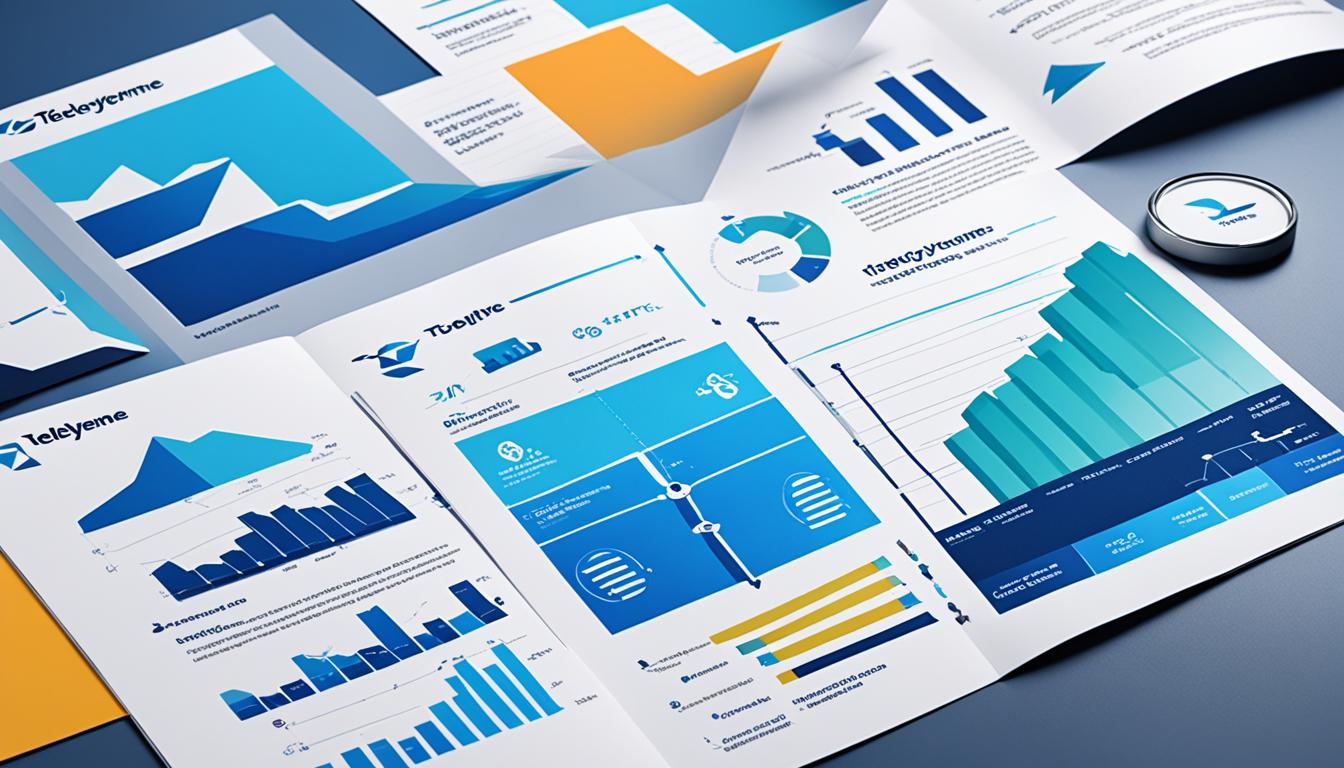Average order value (AOV) is a key metric used in marketing to measure the average dollar amount spent by customers each time they make a purchase on a website or mobile app. It provides insights into customers’ purchasing habits and helps businesses evaluate the effectiveness of their strategies.
To calculate AOV, simply divide the total revenue generated by the total number of orders. By tracking AOV, businesses can identify opportunities to increase their revenue and profitability.
Key Takeaways:
- AOV measures the average dollar amount spent by customers per purchase.
- It helps businesses understand customer purchasing habits and evaluate marketing strategies.
- Increasing AOV can lead to higher revenue and profits.
- Calculating AOV involves dividing total revenue by the total number of orders.
- Tracking AOV allows businesses to identify opportunities for improvement and optimization.
Why does average order value matter?
Average order value (AOV) plays a crucial role in evaluating marketing efforts and pricing strategies for businesses. By understanding the average amount customers spend per order, businesses can assess the long-term value of individual customers and make informed decisions regarding their marketing strategies. This metric also enables businesses to set goals and assess the effectiveness of their efforts to increase customer spending. Ultimately, increasing AOV can directly lead to revenue growth and increased profitability.
Measuring AOV provides businesses with valuable insights into their customers’ purchasing behavior and helps them identify opportunities for improvement. By analyzing AOV, businesses can evaluate the success of their pricing strategies, product bundling, and cross-selling techniques. This metric allows businesses to identify high-value customers, tailor their marketing efforts accordingly, and maximize revenue potential.
Increasing AOV has a direct impact on sales and profitability. By encouraging customers to spend more per order, businesses can boost their overall revenue without necessarily attracting new customers. A higher AOV means higher transaction values and increased profits. By implementing strategies to increase AOV, such as offering upsells, cross-selling, and volume discounts, businesses can optimize their sales funnel, maximize revenue from each customer, and ultimately increase their bottom line.
Benefits of a Higher Average Order Value:
- Increased revenue and profitability
- Improved customer lifetime value
- Optimized marketing strategies
- Ability to set and achieve revenue goals
- Enhanced customer segmentation
- Higher return on advertising spend (ROAS)
| AOV Increase Tactics | Benefits |
|---|---|
| Upselling and cross-selling | Encourages customers to purchase additional products and increase transaction value |
| Volume discounts | Incentivizes customers to spend more in order to qualify for discounts |
| Free shipping thresholds | Encourages customers to add more items to their cart to qualify for free shipping |
| Customer loyalty programs | Rewards customers for higher spending and encourages repeat purchases |
Strategies for improving average order value
To increase average order value (AOV), businesses can implement various effective strategies. By utilizing cross-selling and upselling techniques, customers can be encouraged to purchase additional products or upgrade to more expensive options. Furthermore, offering volume discounts, setting free shipping thresholds, providing coupons, and offering opportunities for donations can incentivize customers to spend more.
Another strategy to consider is segmenting customer groups and tailoring specific offers based on their purchasing behavior. By personalizing offers, businesses can effectively target customers with relevant product suggestions and promotions, thereby increasing the likelihood of higher order values.
Implementing these strategies not only helps businesses improve AOV but also drives revenue growth. The key is to create a seamless shopping experience that entices customers to spend more while also meeting their individual needs and preferences.
Example Strategies for Improving AOV:
- Cross-selling and upselling techniques
- Volume discounts
- Free shipping thresholds
- Coupons
- Donations
- Segmenting customer groups
- Personalizing offers
| Strategy | Description |
|---|---|
| Cross-selling and upselling techniques | Encourage customers to purchase additional products or upgrade to more expensive options. |
| Volume discounts | Offer discounts based on the quantity of items purchased. |
| Free shipping thresholds | Set a minimum order value to qualify for free shipping. |
| Coupons | Provide customers with discount codes to apply at checkout. |
| Donations | Give customers the option to donate a small amount at checkout, incentivizing them to spend more. |
| Segmenting customer groups | Divide customers based on behavior and preferences to tailor offers and promotions. |
| Personalizing offers | Create customized promotions and product recommendations based on individual customer data. |
The importance of tracking other e-commerce key metrics
While focusing on increasing average order value (AOV) is essential, businesses should also pay attention to other key metrics to gain a comprehensive understanding of their e-commerce performance. Two crucial metrics that should be tracked and analyzed are conversion rate and revenue per visitor.
Conversion Rate
Conversion rate measures the percentage of website visitors who complete a desired action, such as making a purchase. It provides insights into the effectiveness of marketing efforts and the overall user experience of the website. A high conversion rate indicates that the website is successful in converting visitors into customers, suggesting that the marketing strategies and website design are performing well.
Tracking conversion rate allows businesses to identify areas for improvement. By analyzing user behavior, businesses can optimize their website’s layout, content, and navigation to enhance the user experience and increase the likelihood of conversions. Implementing conversion rate optimization strategies ensures that businesses are maximizing their revenue potential from the existing traffic.
Revenue per Visitor
Revenue per visitor is another crucial metric that provides important insights into the effectiveness of marketing campaigns and the average value generated from each visitor. By calculating the average amount of money generated per website visit, businesses can evaluate the impact of their marketing efforts and make informed decisions to enhance revenue generation.
An increase in revenue per visitor indicates that visitors are spending more on each visit, leading to higher sales and profits. Tracking revenue per visitor over time allows businesses to identify trends and patterns, helping them identify and capitalize on opportunities to drive more revenue. By optimizing marketing strategies and enhancing the user experience, businesses can attract high-value visitors and maximize revenue potential.
By tracking and analyzing conversion rate and revenue per visitor in addition to AOV, businesses can gain a holistic view of their e-commerce performance. These metrics provide valuable insights that help businesses identify areas for improvement and make data-driven decisions to enhance revenue generation and overall profitability.
Balance between Metrics
While it is important to focus on increasing AOV, businesses must find a balance between optimizing AOV and maintaining a healthy conversion rate and revenue per visitor. Simply striving for higher AOV without considering other metrics might lead to a drop in conversion rate and revenue per visitor if customers feel pressured to spend more or if the overall user experience is compromised.
It is crucial to monitor these metrics collectively and consider how changes made to increase AOV might impact conversion rate and revenue per visitor. Finding the optimal balance between these metrics ensures that businesses are maximizing their revenue potential while providing an excellent customer experience.
| Metric | Definition | Importance |
|---|---|---|
| Conversion Rate | The percentage of website visitors who complete a desired action, such as making a purchase. | Provides insights into the effectiveness of marketing efforts and the user experience. Helps optimize website design and marketing strategies. |
| Revenue per Visitor | The average amount of money generated per website visit. | Measures the impact and effectiveness of marketing campaigns. Identifies trends and opportunities for revenue growth. |
How A/B testing can optimize average order value
A/B testing is a valuable method for optimizing average order value (AOV) in marketing. By testing different variations of strategies such as cross-selling, upselling, and promotional offers, businesses can gather data and determine which approaches lead to the highest AOV. This data-driven approach allows businesses to make informed decisions and continuously optimize their marketing strategies.
Platforms like Optimizely provide real-time results and insights to improve AOV and drive revenue growth. Through A/B testing, companies can identify the most effective strategies that resonate with their target audience, resulting in increased AOV and improved profitability.
A/B testing involves creating two or more versions of a marketing campaign, website element, or offer and randomly assigning different versions to different segments of your audience. By comparing the performance of each version, businesses can analyze and determine which variant generates the highest AOV.
Implementing A/B Testing Methodology
When conducting A/B testing to optimize AOV, it is crucial to follow a structured methodology to ensure accurate results:
- Objective setting: Clearly define the objective of your A/B test. Are you looking to increase AOV by offering free shipping or upselling additional products?
- Hypothesis formulation: Develop a hypothesis about which variation will yield the highest AOV. For example, a hypothesis might be that offering a volume discount will increase the average spend per order.
- Variable selection: Identify the variables you want to test, such as pricing, product placement, or the order of steps in the checkout process.
- Segmentation: Divide your target audience into segments based on relevant characteristics, such as new versus returning customers.
- Testing: Launch your A/B test and track and analyze the results. Compare the AOV of each variant to identify the one that performs best.
By conducting A/B testing on various aspects of your marketing strategy, you can identify the most effective tactics for optimizing AOV. It is important to continuously test and refine your strategies based on data and insights gathered from A/B testing.
| A/B Testing Variation | Average Order Value (AOV) |
|---|---|
| Cross-selling additional products | $120 |
| Upselling to premium products | $150 |
| Offering free shipping for orders over $50 | $110 |
The table above showcases the AOV results from A/B testing different strategies. In this example, upselling to premium products yielded the highest AOV of $150, indicating that this variation is the most effective for increasing customer spending.
A/B testing can provide valuable insights to optimize AOV and maximize revenue. By continuously testing and refining marketing strategies, businesses can uncover valuable data-driven insights that lead to increased AOV and improved profitability.
Challenges in increasing average order value
While businesses strive to increase average order value, they often encounter common challenges that can impede their progress. Understanding and overcoming these challenges is essential in optimizing AOV and driving revenue growth.
One of the main challenges is the resistance to upselling and cross-selling. Some customers may not be interested in additional products or may feel overwhelmed by sales tactics. Effective strategies for mitigating this challenge include providing relevant recommendations based on customer preferences and purchasing history, as well as offering personalized offers that align with their needs and interests.
Another hurdle businesses face is customer backlash to price increases. Customers are often wary of paying more without perceiving any added value. To address this challenge, businesses should focus on communicating the value and benefits of higher-priced products or services. This can be achieved through compelling product descriptions, showcasing unique features, and offering attractive discounts or promotions.
Personalizing offers can be a daunting task for businesses, yet it is a highly effective strategy for increasing AOV. Customized recommendations and tailored promotions can resonate with customers and encourage them to spend more. Investing in data analytics and utilizing customer segmentation can help identify individual preferences and create tailored offers that drive higher order values.
Understanding customer preferences
In order to overcome these challenges and optimize AOV, businesses must invest in understanding customer preferences. Conducting market research, analyzing customer data, and leveraging customer feedback are essential steps in tailoring strategies to appeal to the target audience. By understanding their customers’ needs, desires, and pain points, businesses can adjust their approach and offer relevant incentives that drive increased spending.
Finding the right balance between incentivizing additional spending and maintaining customer satisfaction is crucial. While businesses aim to increase AOV, they must also prioritize the overall customer experience. Pushing customers too hard or making them feel forced to spend more can have negative consequences on customer loyalty and satisfaction.
By navigating these challenges and implementing effective strategies, businesses can overcome barriers to increasing average order value. Understanding customer preferences, personalizing offers, and communicating value are key factors in optimizing AOV and driving revenue growth.
Leveraging website testing to optimize average order value
Website testing is a vital tool for maximizing average order value (AOV) and improving the overall performance of an e-commerce site. By formulating hypotheses, gathering data through analytics, and analyzing test results, businesses can identify areas for improvement and make data-driven changes to increase AOV. This process enables businesses to optimize their websites and enhance profit margins.
There are several tools available that can facilitate website testing and provide valuable insights. Google Analytics is a popular choice for measuring and analyzing website performance, including AOV. It allows businesses to track user behavior, identify patterns, and make informed decisions to optimize their sites.
Additionally, e-commerce platforms like Shopify offer various apps that can help businesses optimize AOV. For example, Zipify One Click Upsell and CartHook Post Purchase Offers enable businesses to implement effective strategies that encourage customers to spend more. These tools provide insights into customer behavior and allow businesses to tailor their strategies accordingly.
Regularly analyzing and tracking AOV is crucial for optimizing an e-commerce site. By monitoring the performance and results of website tests, businesses can identify successful strategies and make continuous improvements. This iterative process empowers businesses to refine their marketing efforts, enhance the user experience, and drive revenue growth.
Benefits of website testing for optimizing average order value
Website testing offers several key benefits when it comes to optimizing AOV:
- Identify high-impact changes: By conducting tests and analyzing the results, businesses can identify specific changes that have the most significant impact on AOV. This data-driven approach ensures that the resources and efforts are focused on strategies that yield the best results.
- Enhance user experience: By tracking user behavior and testing different features and designs, businesses can optimize the user experience to encourage higher spending. A seamless and user-friendly website can boost customer confidence and drive AOV.
- Increase conversion rates: Website testing not only helps optimize AOV but also improves conversion rates. By identifying and addressing any barriers to conversion, businesses can increase the likelihood of customers completing their purchases and further boost AOV.
Ultimately, leveraging website testing as part of an overall optimization strategy is instrumental in driving revenue growth and improving profit margins. By continuously monitoring, analyzing, and implementing data-driven changes, businesses can unlock the full potential of average order value and achieve e-commerce success.
The final word on average order value
Average order value (AOV) is a vital metric for e-commerce businesses as it directly influences revenue and profitability. By implementing effective strategies such as setting order minimums for free shipping, bundling products, upselling, and offering customer loyalty programs, businesses can increase AOV and drive revenue growth. However, it is important to consider other key metrics like conversion rate and revenue per visitor to maintain a balanced approach.
Tracking AOV allows businesses to evaluate the effectiveness of their marketing efforts and pricing strategies. By monitoring AOV, businesses can gain insights into customer spending habits, identify trends, and make informed decisions. It also helps businesses set goals and evaluate the impact of their efforts in increasing customer spending.
Website testing and analytics play a crucial role in optimizing AOV and improving profit margins. By conducting A/B tests and analyzing data, businesses can identify areas for improvement and make data-driven changes. Platforms like Google Analytics and Shopify apps such as Zipify One Click Upsell and CartHook Post Purchase Offers provide valuable insights to implement effective strategies.
An optimized AOV can lead to higher revenue and increased profitability for e-commerce businesses. However, it is important to strike a balance between increasing AOV and maintaining a healthy conversion rate and revenue per visitor. By regularly analyzing and tracking AOV alongside other key metrics, businesses can obtain valuable insights and identify opportunities for optimization.
Conclusion
In conclusion, average order value (AOV) is a crucial metric for understanding customer spending habits and evaluating marketing strategies in the e-commerce industry. By implementing effective strategies such as cross-selling, upselling, and offering incentives like free shipping and volume discounts, businesses can increase AOV and ultimately drive revenue growth.
It is essential for businesses to track and analyze AOV regularly, along with other key metrics, to gain valuable insights and identify opportunities for optimization. By continuously improving AOV and finding the right balance between increasing customer spending and maintaining customer satisfaction, businesses can enhance their profitability and long-term success.
In the highly competitive e-commerce landscape, focusing on AOV allows businesses to maximize the value of each customer transaction and increase their overall revenue and profitability. By prioritizing AOV and implementing a data-driven approach through website testing and analytics, businesses can be proactive in optimizing their marketing strategies and achieving their financial goals.





